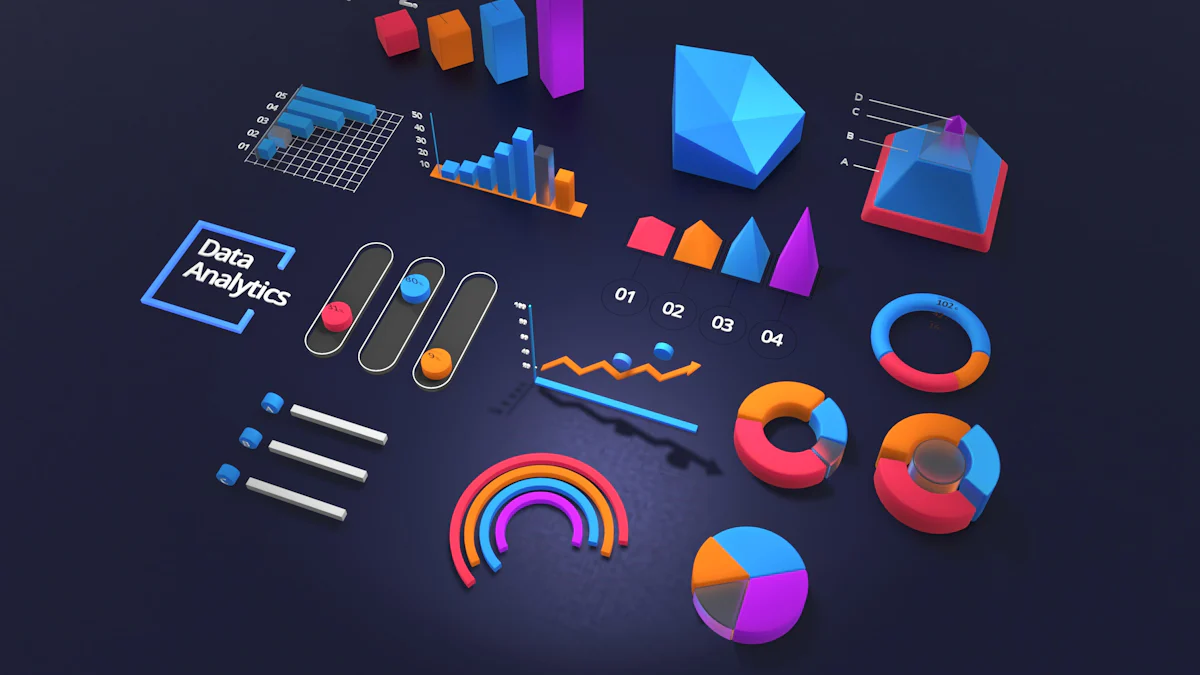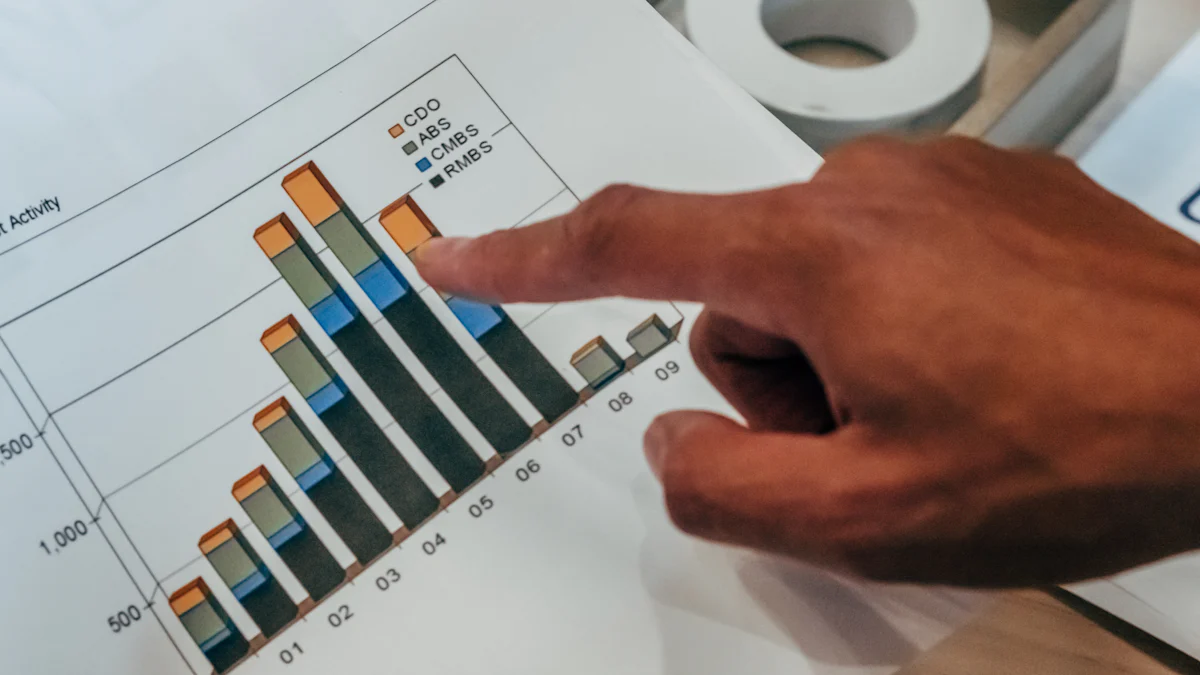


Data visualization helps you make sense of complex information by turning it into visual formats. Among the many tools available, the Spider Plot stands out for its ability to represent intricate data in a clear and engaging way. This chart type allows you to compare multiple variables at once, revealing patterns and insights that might otherwise go unnoticed. Understanding how to read and create Spider Plots can significantly enhance your data analysis skills, making it easier to communicate findings effectively.
Understanding the Spider Plot
Definition and Explanation of a Spider Plot
What is a Spider Plot?
A Spider Plot, also known as a radar chart or web chart, is a unique graphical tool that helps you visualize multivariate data. Imagine a central point with several axes radiating outward. Each axis represents a different variable. This setup allows you to compare multiple parameters at once, making it easier to spot patterns and relationships.
Key Characteristics of Spider Plots
Spider Plots stand out due to their distinctive shape, resembling a spider's web. They use equi-angular spokes, or radii, to represent variables. The data points on each axis connect to form a polygon, providing a visual snapshot of the data's strengths and weaknesses. This makes Spider Plots particularly useful for comparing values across various attributes.
Historical Background of a Spider Plot
Origin of Spider Plots
The concept of the Spider Plot has been around for quite some time. It emerged as a way to simplify complex data visualization. By displaying multiple variables in a single view, Spider Plots became a popular choice for data analysts and researchers.
Evolution in Data Visualization
Over the years, Spider Plots have evolved alongside advancements in data visualization. Initially, they were basic tools for comparing simple datasets. Today, they incorporate advanced features and customizations, enhancing their effectiveness. Despite some criticism, Spider Plots remain valuable for their ability to present multivariate data in an intuitive manner.
Components of a Spider Plot

Axes and Dimensions of a Spider Plot
Explanation of Axes
In a Spider Plot, each axis represents a different variable. You can think of these axes as spokes on a wheel, radiating from a central point. Each spoke corresponds to a specific attribute or category you want to analyze. The length of each axis is proportional to the value it represents. This setup allows you to see how each variable compares to others at a glance.
How Dimensions are Represented
Dimensions in a Spider Plot are represented by the number of axes. More axes mean more dimensions. You can visualize multiple variables simultaneously, making it easier to identify patterns and relationships. Each axis is labeled with the variable it represents, and the data points are plotted along these axes. This method provides a comprehensive view of the data's structure.
Data Points and Lines of a Spider Plot
Plotting Data Points
Plotting data points on a Spider Plot involves marking values on each axis. You start by determining the value of each variable and then plot these values along their respective axes. The position of each point reflects the magnitude of the variable it represents. This step is crucial for creating an accurate visual representation of your data.
Connecting Lines and Their Significance
Once you've plotted the data points, you connect them with lines to form a polygon. These connecting lines are significant because they create a shape that visually represents the data's overall pattern. The shape's size and form can reveal strengths, weaknesses, and trends within the dataset. By examining this polygon, you can quickly assess how different variables relate to one another.
Types of the Spider Plot
When diving into the world of Spider Plots, you'll encounter two main types: simple and complex. Each serves its unique purpose and offers distinct features that cater to different needs.
Simple Spider Plots
Basic Structure
Simple Spider Plots provide a straightforward way to visualize data. Imagine a central point with several axes radiating outward. Each axis represents a variable, and you plot data points along these axes. By connecting the points, you form a polygon that gives you a quick snapshot of your data. This basic structure makes it easy for you to compare multiple variables at once.
Common Uses
You often use simple Spider Plots in scenarios where you need a quick overview of data. They are perfect for comparing a few variables without overwhelming details. For instance, you might use them in performance reviews to compare employee skills or in sports to evaluate player statistics. Their simplicity allows you to grasp the general patterns and trends effortlessly.
Complex Spider Plots
Advanced Features
Complex Spider Plots take things up a notch with advanced features. They allow you to incorporate more variables and offer customization options like color coding and interactive elements. These features enhance the plot's ability to convey intricate data stories. You can adjust the axes, add labels, and even include multiple datasets on a single plot. This flexibility makes complex Spider Plots a powerful tool for detailed analysis.
Applications in Various Fields
In fields requiring the analysis of complex, multivariable information, complex Spider Plots shine. Business analysts use them to compare market trends, while scientists rely on them to visualize experimental results. They condense extensive information into a single, visually engaging format, making them invaluable in areas like finance, marketing, and research. Unlike traditional bar charts or line graphs, Spider Plots excel at showing general patterns and trends, providing a comprehensive view of the data landscape.
Applications of a Spider Plot

Spider Plots are versatile tools that can transform complex data into clear visual stories. Let's explore how you can use them in different fields.
Business and Marketing
Market Analysis
In business, understanding your market position is crucial. Spider Plots help you compare products based on multiple features. By visualizing these comparisons, you can identify strengths and weaknesses. This insight guides strategic decisions and marketing efforts. For example, you might analyze customer preferences or product performance across various attributes. The visual clarity of a Spider Plot makes it easier to spot trends and make informed choices.
Competitor Comparison
Keeping an eye on competitors is vital for staying ahead. Spider Plots allow you to compare your offerings with those of your competitors. You can visualize differences in features, pricing, and customer satisfaction. This comparison helps you understand where you stand in the market. By identifying gaps, you can adjust your strategies to gain a competitive edge. The ability to see all this information at a glance makes Spider Plots invaluable in competitive analysis.
Scientific Research
Data Analysis
In scientific research, data analysis often involves multiple variables. Spider Plots provide a way to visualize these variables simultaneously. They help you uncover patterns and relationships within your data. For instance, researchers might use Spider Plots to compare experimental results across different conditions. This visual representation simplifies complex datasets, making it easier to draw meaningful conclusions.
Visualizing Experimental Results
When presenting experimental results, clarity is key. Spider Plots offer a clear and engaging way to showcase findings. You can highlight differences and similarities across various parameters. This visualization aids in communicating your research effectively. Whether you're sharing results with colleagues or presenting at a conference, Spider Plots enhance understanding and engagement.
By using Spider Plots, you can turn intricate data into accessible insights. Whether in business or research, these plots help you make sense of complex information, guiding decisions and enhancing communication.
Advantages of Using the Spider Plot
Spider Plots offer several advantages that make them a valuable tool in data visualization. Let's explore how they can enhance your understanding and adaptability.
Visual Clarity
Simplifying Complex Data
Spider Plots excel at turning complex data into simple visuals. You can easily compare multiple variables in one graphic. This clarity helps you spot patterns and trends without getting lost in numbers. By visualizing data this way, you make it more accessible and engaging.
Enhancing Understanding
When you use a Spider Plot, you create a visual story. This storytelling aspect makes it easier for others to grasp the insights you're sharing. The unique shape of the plot highlights strengths and weaknesses, allowing you to communicate findings effectively. It's like giving your data a voice that speaks clearly to your audience.
Versatility
Adaptability to Different Data Sets
One of the standout features of Spider Plots is their versatility. You can adapt them to various data sets, whether you're dealing with business metrics or scientific research. This adaptability means you can use Spider Plots across different fields, making them a go-to tool for many analysts.
Use in Various Industries
Spider Plots find applications in numerous industries. In business, they help with market analysis and competitor comparison. In science, they visualize experimental results. Their ability to convey multivariate data in a single view makes them indispensable. You can rely on Spider Plots to provide a comprehensive overview, no matter the industry.
By leveraging the advantages of Spider Plots, you can transform complex data into clear, insightful visuals. Whether you're simplifying data or adapting to different fields, these plots offer a powerful way to enhance your analysis and communication.
Limitations of a Spider Plot
While Spider Plots offer a unique way to visualize data, they come with some limitations you should consider.
Interpretation Challenges
Misleading Representations
Spider Plots can sometimes create misleading visuals. The shape of the polygon might suggest patterns that aren't truly there. For example, the area inside the plot can exaggerate differences between variables. This can lead you to incorrect conclusions if you're not careful.
Overlapping Data Issues
When you have many variables, data points can overlap. This clutter makes it hard to distinguish between different values. You might struggle to see individual data points clearly, which can obscure important insights.
Data Complexity
Handling Large Data Sets
Spider Plots aren't always the best choice for large datasets. Too many variables can make the plot look crowded and confusing. You might find it challenging to interpret the data accurately when there's too much information packed into one plot.
Limitations in Detail Representation
Spider Plots often lack precision in representing detailed data. The radial scale can distort values, making it tough to judge exact quantities. This limitation means you might miss out on subtle differences that other visualization tools could highlight.
Despite these challenges, Spider Plots remain valuable for specific applications. They work well when you need a quick overview or when comparing a few key variables. Just be mindful of their limitations and use them wisely to ensure accurate data interpretation.
Best Practices for Creating a Spider Plot
Creating an effective Spider Plot involves careful planning and attention to detail. By following best practices, you can ensure your plots are both informative and visually appealing. Let's dive into some key considerations.
Data Selection
Choosing Relevant Data
When crafting a Spider Plot, start by selecting the most relevant data. Focus on variables that provide meaningful insights. Avoid cluttering your plot with unnecessary information. This approach helps maintain clarity and ensures your audience can easily interpret the data. Think about what you want to convey and choose data points that support your narrative.
Ensuring Data Accuracy
Accuracy is crucial in any data visualization. Double-check your data before plotting it. Ensure that each value is correct and up-to-date. Inaccurate data can lead to misleading conclusions. By verifying your data, you build trust with your audience and enhance the credibility of your Spider Plot.
Design Considerations
Color and labeling play a significant role in the effectiveness of a Spider Plot. Use colors to differentiate between variables or datasets. This visual distinction makes it easier for viewers to follow the plot. However, avoid using too many colors, as this can overwhelm the viewer. Labels should be clear and concise, providing enough information without cluttering the plot. Consistent scaling across all variables is also essential to maintain uniformity and prevent misinterpretation.
Color and labeling play a significant role in the effectiveness of a Spider Plot. Use colors to differentiate between variables or datasets. This visual distinction makes it easier for viewers to follow the plot. However, avoid using too many colors, as this can overwhelm the viewer. Labels should be clear and concise, providing enough information without cluttering the plot. Consistent scaling across all variables is also essential to maintain uniformity and prevent misinterpretation.
Ensuring Readability
Readability is key to a successful Spider Plot. Keep your design simple and straightforward. Ensure that the text is legible and the plot is not overcrowded. Use a clean layout that guides the viewer's eye naturally from one point to another. By prioritizing readability, you make it easier for your audience to grasp the insights your Spider Plot offers.
By adhering to these best practices, you can create Spider Plots that effectively communicate complex data. Whether you're presenting business metrics or scientific findings, these plots can transform intricate information into clear, engaging visuals.
Comparing Spider Plot with Other Visualization Tools
Radar Charts
Similarities and Differences
You might wonder how spider plots and radar charts differ. Well, they don't! They're actually the same thing. Both display data across multiple variables using a two-dimensional polygon. This setup lets you compare several dimensions at once. The unique shape, resembling a spider's web, makes them visually engaging and effective for spotting patterns.
When to Use Each
Since spider plots and radar charts are identical, you can use them interchangeably. They're perfect when you need to visualize multivariate data in a single graphic. Whether you're analyzing business metrics or scientific data, these charts help you see relationships and trends quickly. Use them when you want a comprehensive view of your data's strengths and weaknesses.
Bar and Line Graphs
Comparative Analysis
Bar and line graphs offer different insights compared to spider plots. Bar graphs excel at showing individual data points and comparing them side by side. Line graphs, on the other hand, are great for illustrating trends over time. Spider plots, however, condense extensive information into a single format, allowing for intuitive comparison across multiple variables.
Advantages and Disadvantages
Spider plots shine when you need to compare several unique dimensions simultaneously. They provide a quick snapshot of complex data. However, they might not be the best choice for detailed analysis of individual variables. Bar and line graphs offer more precision for specific data points but lack the ability to show multivariate relationships in one view.
Spider plots offer a unique way to visualize complex, multidimensional data. They help you uncover patterns and insights that might otherwise remain hidden. By exploring spider plots, you can enhance your data analysis skills and communicate findings more effectively.
Consider incorporating spider plots into your toolkit. They transform intricate data into coherent stories, making them invaluable in various fields. As data visualization continues to evolve, tools like spider plots will play a crucial role in shaping how we understand and present information. Embrace these tools to stay ahead in the ever-changing landscape of data analysis.
FAQ
A Spider Plot, also known as a radar chart, is a graphical tool that displays data across multiple variables. It resembles a spider's web, with each axis representing a different variable. This setup allows you to compare several dimensions simultaneously, making it easier to spot patterns and relationships.
You should use a Spider Plot when you need to visualize multivariate data in a single graphic. It's perfect for comparing multiple variables at once, whether you're analyzing business metrics or scientific data. The unique shape helps you see relationships and trends quickly.
To interpret a Spider Plot, look at the shape formed by the connecting lines. The size and form of the polygon reveal strengths, weaknesses, and trends within the dataset. For example, if one axis extends further than others, it indicates a higher value for that variable.
Spider Plots can sometimes create misleading visuals. The shape of the polygon might suggest patterns that aren't truly there. Overlapping data points can also make it hard to distinguish between different values. They aren't always the best choice for large datasets or detailed analysis of individual variables.
Absolutely! You can customize Spider Plots with color coding, labels, and interactive elements. These features enhance the plot's ability to convey intricate data stories. Adjusting axes and adding multiple datasets can make your Spider Plot a powerful tool for detailed analysis.
Yes, they are! Spider Plots and Radar Charts are two names for the same visualization tool. Both display data across multiple variables using a two-dimensional polygon, allowing for intuitive comparison across several dimensions.
Sure! Imagine a journal article analyzing 14 types of beer. The Spider Plot might show sensory attributes like sour, bitter, and sweet for each beer type. This visual representation helps you quickly identify which beers have the strongest flavors.
Continue Reading About Spider Plot
2025 Best Data Integration Solutions and Selection Guide
Explore top data integration solutions for 2025, enhancing data management and operational efficiency with leading platforms like Fivetran and Talend.
Howard
Dec 19, 2024
Best Data Integration Platforms to Use in 2025
Explore the best data integration platforms for 2025, including cloud-based, on-premises, and hybrid solutions. Learn about key features, benefits, and top players.
Howard
Jun 20, 2024
15 Best Software Reporting Tools for 2025
Explore the top 15 software reporting tools for 2025. Compare features, pricing, and usability to find the best fit for your business needs.
Lewis
Oct 08, 2024


